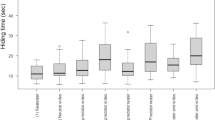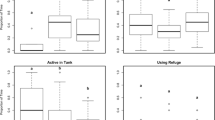Abstract
Organisms rely on sensory cues to interpret their environment and make important life-history decisions. Accurate recognition is of particular importance in diverse reef environments. Most evidence on the use of sensory cues focuses on those used in predator avoidance or habitat recognition, with little information on their role in conspecific recognition. Yet conspecific recognition is essential for life-history decisions including settlement, mate choice, and dominance interactions. Using a sensory manipulated tank and a two-chamber choice flume, anemonefish conspecific response was measured in the presence and absence of chemical and/or visual cues. Experiments were then repeated in the presence or absence of two heterospecific species to evaluate whether a heterospecific fish altered the conspecific response. Anemonefishes responded to both the visual and chemical cues of conspecifics, but relied on the combination of the two cues to recognize conspecifics inside the sensory manipulated tank. These results contrast previous studies focusing on predator detection where anemonefishes were found to compensate for the loss of one sensory cue (chemical) by utilizing a second cue (visual). This lack of sensory compensation may impact the ability of anemonefishes to acclimate to changing reef environments in the future.





Similar content being viewed by others
References
Allen GR, Drew J, Kaufman L (2008) Amphiprion barberi, a new species of anemonefish (Pomacentridae) from Fiji, Tonga, and Samoa. Aqua 14:105–114
Allen GR, Drew J, Fenne D (2010) Amphiprion pacificus, a new species of anemonefish (Pomacentridae) from Fiji, Tonga, Samoa, and Wallis Island. Aqua 16:129–138
Arvedlund M, McCormick MI, Fautin D, Bildsoe M (1999) Host recognitioin and possible imprinting in the anemonefish Amphiprion melanopus (Pisces: Pomacentridae). Mar Ecol Prog Ser 188:207–218
Buston P (2003) Forcible eviction and prevention of recruitment in the clown anemonefish. Behav Ecol 14:576–582
Bouwma P, Hazlett BA (2001) Integration of multiple predator cues by the crayfish Orconectes propinques. Anim Behav 61:771–776
Camp EF, Hobbs JA, De Brauwer M, Drumbrell AJ, Smith DJ (2016) Cohabitation promotes high diversity of clownfishes in the Coral Triangle. Proc R Soc Lond B Biol Sci 283:20160277
Candolin U (2003) The use of multiple cues in mate choice. Biol Rev Camb Philos Soc 78:575–595
Colleye O, Parmentier E (2012) Overview on the diversity of sounds produced by clownfishes (Pomacentridae): importance of acoustic signals in their peculiar way of life. PLoS One 7:e49179
de Caprona MD, Ryan MJ (1990) Conspecific mate recognition in swordtails, Xiphophorus nigrensis and X. pygmaeus (Poeciliidae): olfactory and visual cues. Anim Behav 39:290–296
Devine BM, Munday PL, Jones GP (2012a) Rising CO2 concentrations affect settlement behaviour of larval damselfishes. Coral Reefs 31:229–238
Devine BM, Munday PL, Jones GP (2012b) Homing ability of adult cardinalfish is affected by elevated carbon dioxide. Oecologia 168:269–276
Dixson DL, Munday PL, Jones GP (2010) Ocean acidification disrupts the innate ability of fish to detect predatory olfactory cues. Ecol Lett 13:68–75
Dixson DL, Pratchett MS, Munday PL (2012) Reef fishes innately distinguish predators based on olfactory cues associated with recent prey items rather than individual species. Anim Behav 84:45–51
Dixson DL, Jones GP, Munday PL, Pratchett MS, Srinivasan M, Planes S, Thorrold SR (2011) Terrestrial cues help coral reef fish larvae locate settlement habitat surrounding islands. Ecol Evol 1:586–595
Dixson DL, Jones GP, Munday PL, Planes S, Pratchett MS, Srinivasan M, Syms C, Thorrold SR (2008) Coral reef fish smell leaves to find island homes. Proc R Soc Lond B Biol Sci 275:2831–2839
Elliott JK, Mariscal RN (2001) Coexistence of nine anemonefish species: differential host and habitat utilization size, and recruitment. Mar Biol 138:23–36
Elliot JK, Elliot JM, Mariscal RN (1995) Host selection, location, and association behaviours of anemonefish in field settlement experiments. Mar Biol 122:377–389
Fautin D (1991) The anemonefish symbiosis: what is known and what is not. Symbiosis 10:23–46
Fautin DG, Allen GR (1997) Anemonefishes and their host sea anemones: a guide for aquarists and divers. Western Australian Museum, Perth, Australia
Ferrari MCO, McCormick MI, Munday PL, Meekan MG, Dixson DL, Lonnstedt O, Chivers DP (2011) Putting prey and predator into the CO2 equation—qualitative and quantitative effects of ocean acidification on predator–prey interactions. Ecol Lett 14:1143–1148
Fisher HS, Wong BBM, Rosenthal GG (2006) Alteration of the chemical environment disrupts communication in a freshwater fish. Proc R Soc Lond B Biol Sci 273:1187–1193
Gainsford A, van Herwerden L, Jones GP (2015) Hierarchical behavior, habitat use and species size difference shape evolutionary outcomes of hybridization in a coral reef fish. J Evol Biol 28:205–222
Gerlach GJ, Atema M, Kingsford J, Black KP, Miller-Sims V (2007) Smelling home can prevent dispersal of reef fish larvae. Proc Natl Acad Sci U S A 104:858–863
Hartman EJ, Abrahams MV (2000) Sensory compensation and the detection of predators: the interaction between chemical and visual information. Proc Natl Acad Sci U S A 267:571–575
Huijbers CM, Nagelkerken I, Lössbroek PC, Schulten IE, Siegenthaler A, Holderied MW, Simpson SD (2012) A test of the senses: fish select novel habitats by responding to multiple cues. Ecology 93:46–55
Karplus I, Katzenstein R, Goren M (2006) Predator recognition and social facilitation of predator avoidance in coral reef fish Dascyllus marginatus juveniles. Mar Ecol Prog Ser 319:215–223
Kingsford MJ, Leis JM, Shanks A, Lindeman KC, Morgan SG, Pineda J (2002) Sensory environments, larval abilities and local self-recruitment. Bull Mar Sci 70:309–340
Larson JK, McCormick MI (2005) The role of chemical alarm signals in facilitating learned recognition of novel chemical cues in a coral reef fish. Anim Behav 69:51–57
Leahy SM, McCormick MI, Mitchell MD, Ferrari MCO (2011) To fear or to feed: the effects of turbidity on perception of risk by a marine fish. Biol Lett 7:811–813
Lecchini D, Shima J, Banaigs B, Galzin R (2005) Larval sensory abilities and mechanisms of habitat selection of a coral reef fish during settlement. Oecologia 143:326–334
Leis JM, Siebeck U, Dixson DL (2011) How Nemo finds home: the neuroecology of dispersal and of population connectivity in larvae of marine fishes. Integr Comp Biol 51:826–843
Litsios G, Kostikova A, Salamin N (2014) Host specialist clownfish are environmental niche generalists. Proc R Soc Lond B Biol Sci 281:20133220
Lönnstedt OM, Munday PL, McCormick MI, Ferrari MCO, Chivers DP (2013) Ocean acidification and responses to predators: can sensory redundancy reduce the apparent impacts of elevated CO2 on fish? Ecol Evol 3:3565–3575
Manassa RP, Dixson DL, McCormick MI, Chivers DP (2013) Coral reef fish incorporate multiple sources of visual and chemical information to mediate predation risk. Anim Behav 86:717–722
McCormick MI, Manassa R (2008) Predation risk assessment by olfactory and visual cues in a coral reef fish. Coral Reefs 27:105–113
Munday PL, Dixson DL, Donelson JM, Jones GP, Pratchett MS, Devitsina GV, Døving KB (2009) Ocean acidification impairs olfactory discrimination and homing ability of a marine fish. Proc Natl Acad Sci U S A 106:1848–1852
Ollerton J, McCollin D, Fautin DG, Allen GR (2007) Finding NEMO: nestedness engendered by mutualistic organization in anemonefish and their hosts. Proc R Soc Lond B Biol Sci 274:591–598
Parmentier E, Lecchini D, Frederich B, Brie C, Mann D (2009) Sound production in four damselfish (Dascyllus) species: phyletic relationships? Biol J Linn Soc Lond 97:928–940
Ross RM (1978) Territorial behavior and ecology of the anemonefish Amphiprion melanopus on Guam. Ethology 46:71–83
Schoeppner NM, Relyea RA (2005) Damage, digestion, and defence: the roles of alarm cues and kairomones for inducing prey defences. Ecol Lett 8:505–512
Siebeck U, Losey GS, Marshall J (2006) UV communication in fish. In: Ladich F, Collin SP, Moller P, Kapoor BG (eds) Communication in fishes. Science Publishers Inc, Enfield, USA, pp 423–456
Simpson SD, Munday PL, Wittenrich ML, Manassa R, Dixson DL, Gagliano M, Yan H (2011) Ocean acidification erodes crucial auditory behaviour in a marine fish. Biol Lett 7:917–920
Stauffer H-P, Semlitsch RD (1993) Effects of visual, chemical, and tactile cues of fish on the behavioural responses of tadpoles. Anim Behav 46:355–364
Sweatman H (1988) Field evidence that settling coral reef fish larvae detect resident fishes using dissolved chemical cues. J Exp Mar Bio Ecol 124:163–174
van der Meer MH, Jones GP, Hobbs JPA, van Herwerden L (2012) Historic hybridization and introgression between two iconic Australian anemonefish and contemporary patterns of population connectivity. Ecol Evol 2:1592–1604
Acknowledgements
We thank Sustainable Aquatics, Tennessee for supplying anemonefish, and KD Koppel and MM Ashur for assistance in animal husbandry. The Alfred P. Sloan Foundation and Georgia Institute of Technology funded the research. Animal care and experimental protocols complied with animal ethics regulations and approvals from Georgia Institute of Technology. Ethics approval number A14035.
Author information
Authors and Affiliations
Corresponding author
Additional information
Communicated by Ecology Editor Dr. Alastair Harborne
Electronic supplementary material
Below is the link to the electronic supplementary material.
Rights and permissions
About this article
Cite this article
Johnston, N.K., Dixson, D.L. Anemonefishes rely on visual and chemical cues to correctly identify conspecifics. Coral Reefs 36, 903–912 (2017). https://doi.org/10.1007/s00338-017-1582-9
Received:
Accepted:
Published:
Issue Date:
DOI: https://doi.org/10.1007/s00338-017-1582-9




